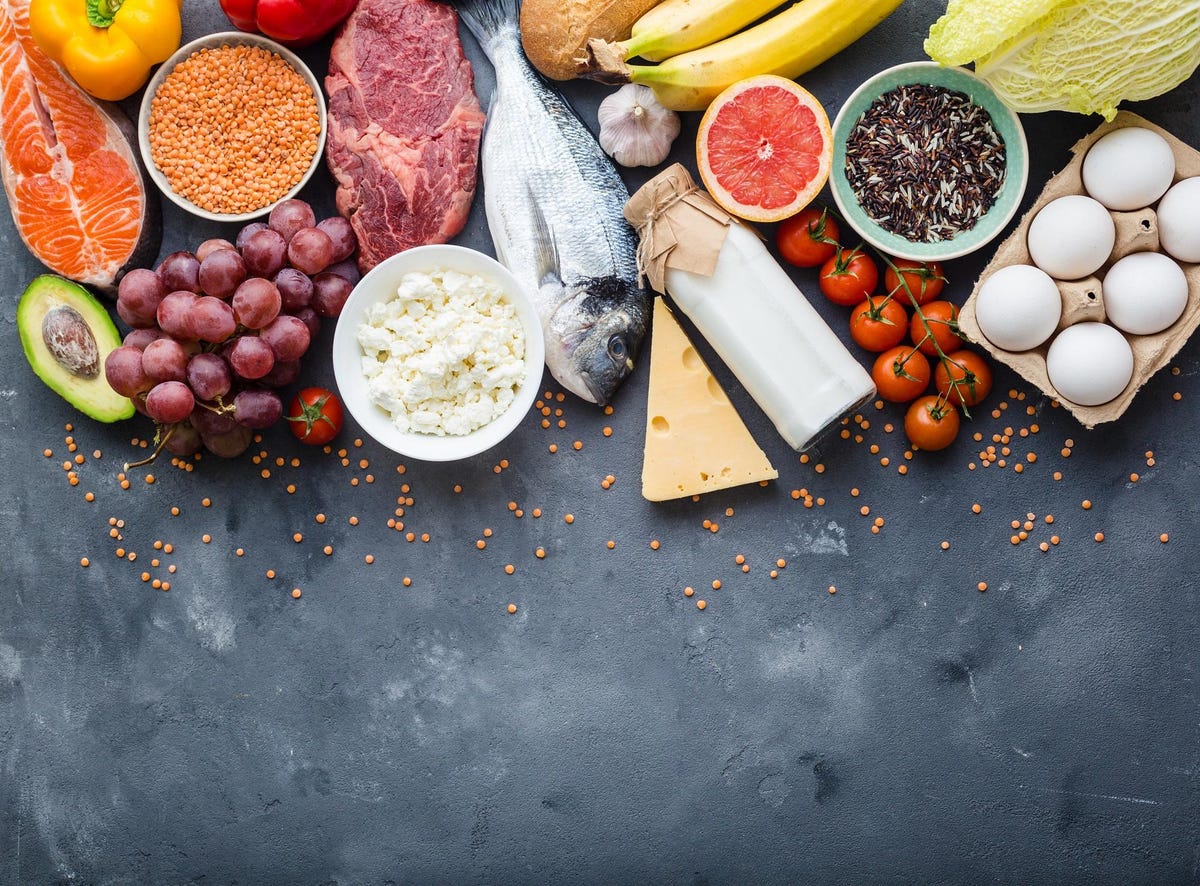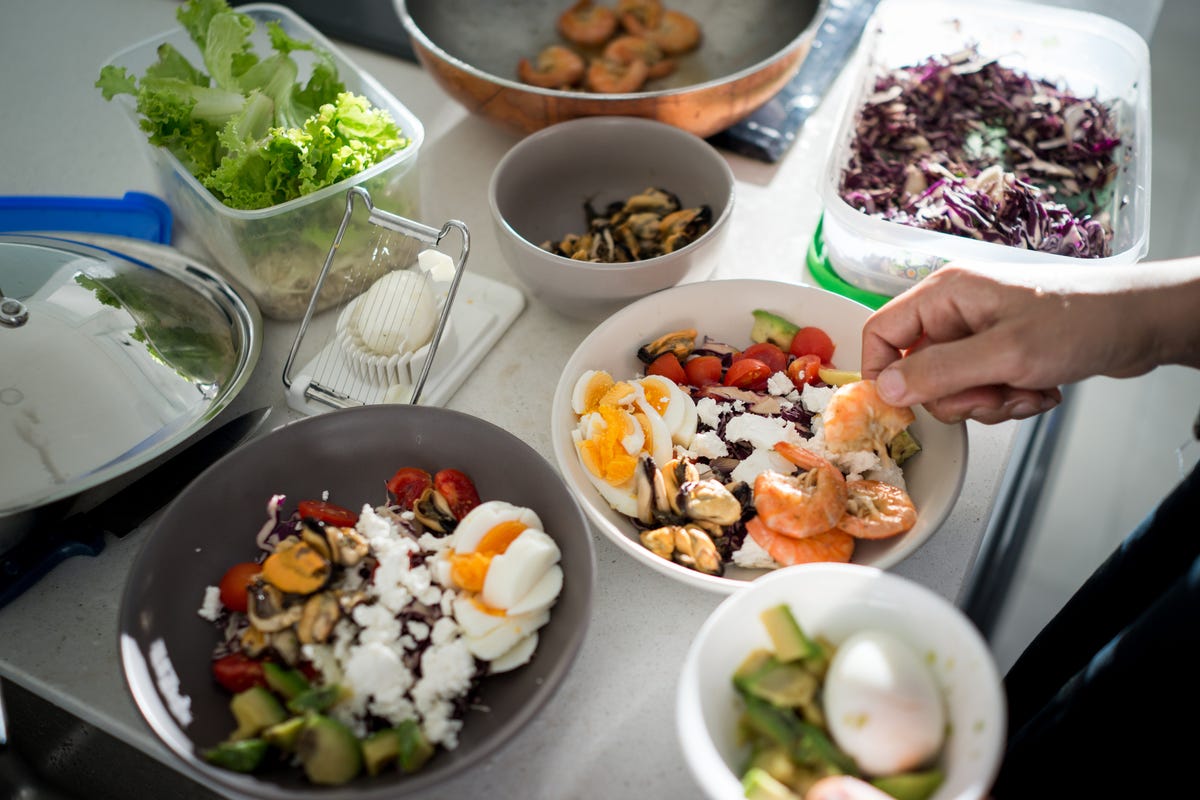The Atkins diet was first developed by cardiologist Robert C. Atkins in the 1960s. Atkins then published a best-selling book in 1972 titled Dr. Atkins’ Diet Revolution. From there, the popularity of this carb-controlled diet took off. Today, the Atkins diet is still one of the most-sought-out weight loss diets.
What is the Atkins diet?
Atkins is a low-carb diet designed for weight loss. Similar to a ketogenic diet, Atkins helps the body burn fat instead of sugar from carbohydrates. On this diet, you restrict your simple carbohydrate intake (white bread, baked goods, sugars, etc.) and turn to more fiber-rich, nutrient-dense vegetables, fruits and complex carbohydrates. This diet also allows fats, meats and full-fat dairy. While calorie counting is not required, you must keep track of how many carbs you eat a day (more on that later).
Atkins’ four-phase plan
The Atkins diet has four phases: introduction, balancing, pre-maintenance and lifetime maintenance. The first phase is the strictest, requiring you to cut out almost all carbohydrates. The second and third phases involve slowly adding in more carbs from vegetables, whole grains, nuts, seeds and some fruits. The fourth phase is taking what you learned from Atkins and applying it to your lifelong diet. You can eat as many healthy carbs as your body allows in this phase.
While most may start with phase one, you can start with any of the first three phases.
Atkins diet benefits and risks
In addition to being a diet that gets you to eat more whole foods such as fruits, vegetables and meats, the Atkins diet has a few other health benefits.
Possible weight loss
Atkins is known as a weight loss plan due to the results that some people have on a low-carb diet. When the body is in ketosis, it will use fat as energy since it is being deprived of carbohydrates. In theory, the body would burn fat instead of storing it.
In one study that looked at popular diets, Atkins was a diet that showed the most potential for meaningful long-term and short-term weight loss. Note that in this study, exercise was encouraged in addition to the diet.
The other possible benefits of the Atkins diet include having more energy, feeling full and may even helping improve other health conditions such as heart disease and diabetes. However, more research is needed to back up these claims.
Even though the Atkins diet boasts many benefits, there are potential risks that need to be taken into account. A low-carb diet can cause the following:
- Dizziness
- Weakness
- Fatigue
- Kidney problems such as kidney stones
- Low blood sugar
- Nausea
- Vitamin deficiency
- High cholesterol
How does the Atkins diet work?
The Atkins diet cuts out a majority of carbohydrates and sugars from your diet and instead focuses on carbs from vegetables, proteins and healthy fats. While you don’t have to count calories in any phase of the diet, you do need to keep track of your net carbs.
How to calculate your net carbs
Net carbs is a calculation of the total carbohydrate content of each food item, minus the good stuff — fiber. This method helps you get an idea of how foods affect your blood sugar levels. For example, nutrient-dense vegetables will have a low net carb score and will not largely affect your blood sugar level nor weight gain. Here’s how to calculate net carbs:
Net carbs = total carbohydrates – fiber – sugar alcohol (if applicable)
Counting your net carbs is one of the trickier aspects of the Atkins diet. Depending on the phase, there is a set maximum and minimum. The following is how many net carbs and food groups you are allowed in each stage of the Atkins diet.
Introduction (phase one): The strictest phase allows under 20 grams of net carbs per day. Eat low-carb vegetables, meats and high-fat dairy in the introduction phase. Stay in this phase for two weeks.
Balancing (phase two): In this phase, you can slowly add in nuts and seeds, more vegetables and lower sugar fruits. Continue to stay away from foods with added sugars and simple carbs. Your net carbs should still be around 20 grams per day, and make sure at least 12 to 15 of those carbs are coming from vegetables. Stay in this phase until you are close to your goal weight or when you think it is time to move on.
Pre-maintenance (phase three): This phase allows you to add back in whole grains, fruits and starchy vegetables. You can add about 10 grams of the already allowed carbs each week. If you start gaining weight again, cut back on your carb intake. Stay in this phase until you meet your goal weight.
Lifetime maintenance (phase four): Move into this phase when you find a healthy balance of carbs in your life. Carry this with you for a lifetime.
Foods to eat on the Atkins diet

Each phase of the Atkins diet has a set of acceptable foods. Depending on the phase you are on, the list below may include some foods that you must limit. In general, these following foods are accepted on the diet:
- Fiber and nutrient-rich vegetables: asparagus, broccoli, celery, cucumber, salad greens, avocado, green beans, bell peppers, etc.
- Meats: lamb, beef, pork, chicken and turkey
- Lower sugar fruits: melon, berries, cherries, apples, grapefruits and oranges
- Full-fat dairy: cheese, cream and butter
- Fatty fish: salmon, sardines, mackerel and trout
- Oils: extra-virgin olive oil, avocado oil, coconut oil
- Eggs
- Whole grains (pre-maintenance phase and after)
- Nuts and seeds (balancing phase and after)
As for accepted beverages, try to stick to water, coffee (without added sugar) and green, black or herbal tea. You can drink alcohol on the Atkins diet but in small amounts, although avoid sugary and high-carb alcoholic drinks (i.e., beer) .
Foods to limit on the Atkins diet
While the phase of the diet you are currently in may slowly let you add more foods back into your diet, these foods are generally not allowed on the Atkins diet. If you struggle with completely avoiding these following foods, try to at least limit them.
- High-starch vegetables (potatoes and corn)
- Fruits that are high in sugar (pineapple, mango, banana)
- Baked goods and sweets (cake, donuts, candy)
- Processed or refined grains
- Sugary beverages
- Simple carbohydrates
Note that during the induction phase (first phase), high-carb vegetables and fruits, starches and legumes are also not allowed.
Atkins meal ideas
Fill your grocery list with these meal ideas for the week. Keep in mind that some of these meals might include food items that your phase might not accept.
Breakfast
- Whole-grain waffles with butter and berries
- Scrambled eggs cooked with extra-virgin olive oil and bacon
Lunch
- Classic chicken or egg salad
- Low-carb creamy chicken and kale soup
Dinner
- Grilled or baked salmon over greens with olive oil and vinegar dressing
- Steak, asparagus and cauliflower
Snacks
- Celery and hummus
- Greek yogurt with almonds and berries
Is the Atkins diet for you?

Although Atkins may work for some people, it isn’t recommended for everyone. Always speak with your doctor before starting a new diet. They can help determine if it is right for you. Here are a few points to consider before starting the Atkins diet.
You should try the Atkins diet if:
- You feel that you already eat too many carbs in a day and want to cut back
- You are already gluten-free
- You want to entirely change your eating habits long term
Try another diet or seek a dietitian if:
- You have high cholesterol, kidney disease or heart disease
- You don’t do well with lots of dietary restrictions and rules
- You are an athlete that relies on carbohydrates
- You have a history of disordered eating
Atkins diet FAQs
What is the difference between keto and Atkins diets?
While both keto and Atkins diets require limiting your intake of carbs and help the body burn fat instead of sugar, the Atkins diet doesn’t have a limit on your intake of protein. As long as you are staying under the recommended maximum number of net carbs, you can have as much protein as you wish. Also, a keto diet needs your body to stay in ketosis during the entire diet. On an Atkins diet, your body may possibly only go into ketosis during the first or second phase.
How many carbs should you have a day on Atkins?
The number of carbs you should have a day on Atkins depends on which phase you are in. The first phase, introduction, requires you to stay under 20 net carbs a day. The second phase is similar with about 20 net carbs a day and about 12 to 15 of those carbs coming from vegetables. The third phase allows adding in 10 extra net carbs a week until you find the right balance.
Is Atkins good for losing belly fat?
Atkins could, hypothetically, help you lose belly fat, because the diet helps your body convert energy from stored fat. This method may help someone on the Atkins diet to help them lose weight, but it will not work for everyone. Speak with your doctor before starting Atkins or any diet.
The information contained in this article is for educational and informational purposes only and is not intended as health or medical advice. Always consult a physician or other qualified health provider regarding any questions you may have about a medical condition or health objectives.
Source: bing.com




















